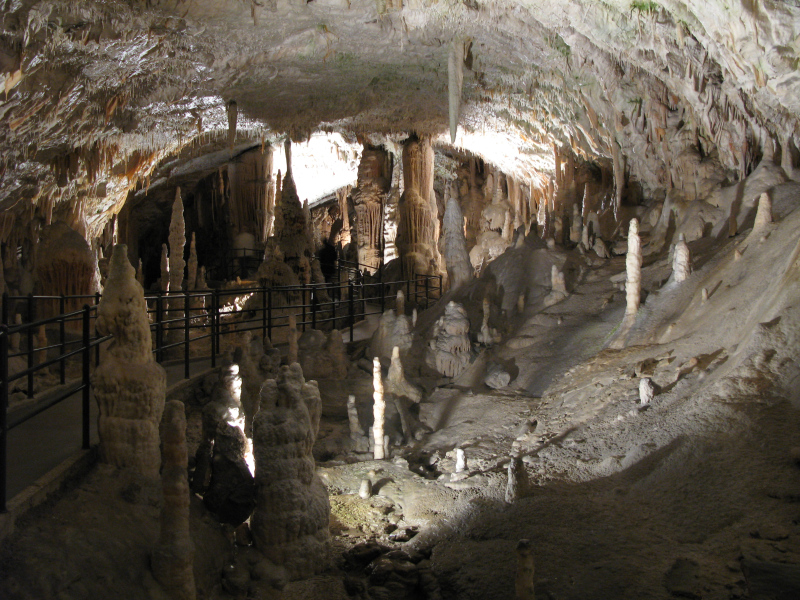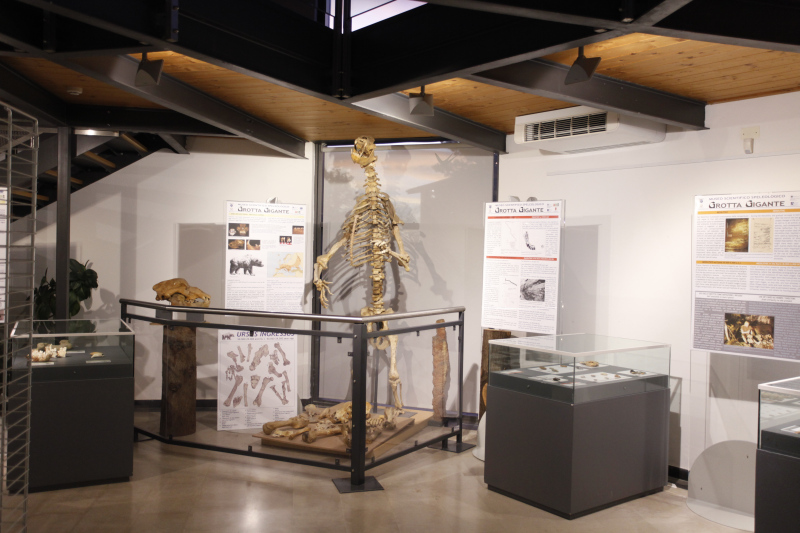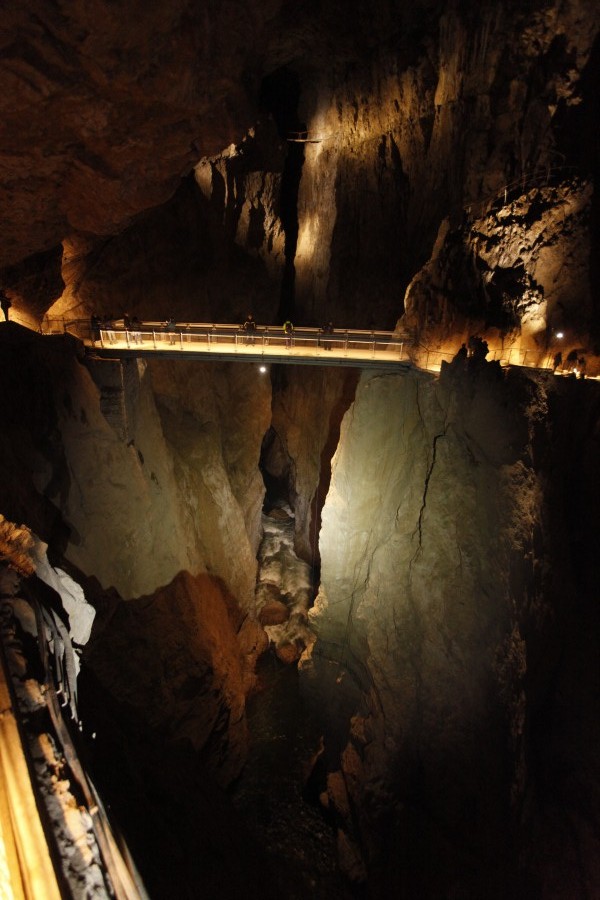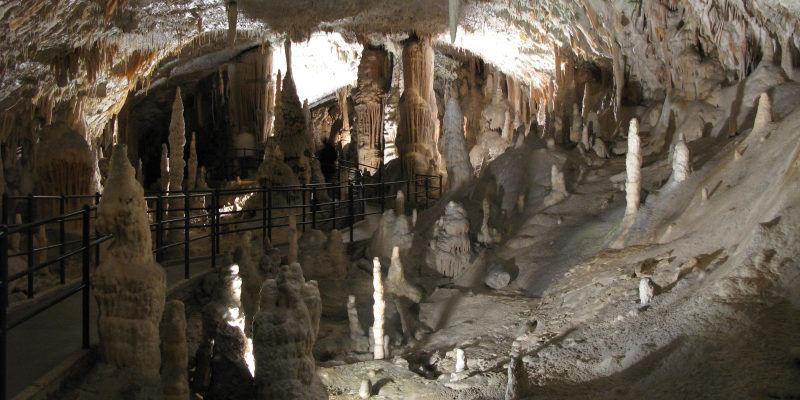In occasione del corso di perfezionamento organizzato dall’AGTI per le guide di grotta, i dirigenti e le guide della Grotta del Vento hanno visitato alcune cavità attrezzate per le visite in Italia, in Slovenia ed in Croazia. Ecco le impressioni.
POSTOJNSKA JAMA (Slovenia)
La prima grotta che abbiamo visitato è stata la Postojnska Jama (ex Adelsberger Hohle, ex Grotta di Postumia): la grotta turistica più famosa del mondo. Appena si arriva si resta colpiti dall’imponenza e dall’efficienza delle strutture esterne. Parcheggi immensi, in grado di ospitare centinaia di auto e decine di pullman, il grande parco sorto nei pressi dell’inghiottitoio della Piuca, l’imponenza e la raffinatezza dell’Hotel Jama, di recente ristrutturato, i negozi dalle vetrine scintillanti, i bar, i punti di ristoro, i chioschi per la vendita dei souvenir, il museo, il vivarium degli animali cavernicoli, la pulizia e l’abbondanza dei servizi igienici, e la sontuosa scalinata che conduce allo splendido edificio liberty che domina il piazzale dal quale i gruppi si dirigono verso la grotta.
Completa l’interesse eccezionale del sito la vicinanza di attrattive quali la Grotta della Piuca, voragine che confluisce nel sistema della Grotta di Postumia, il gigantesco Cavernone di Planina, visitabile su prenotazione, mediante il quale la Piuca rivede la luce dopo aver ricevuto le acque provenienti dal parco naturale “Rakov Skocian”, dove si può ammirare il più vasto assortimento di fenomeni carsici ipogei e di superficie. Poco più distante il suggestivo castello di Predjama, interamente contenuto all’interno di un enorme caverna illuminata dalla luce solare, sovrasta un’altra grotta, in parte visitabile, che ha uno sviluppo di ben 12 chilometri.
Appena si entra nella Grotta di Postumia si resta colpiti dall’eleganza della stazione e dal perfetto allineamento dalle banchine al pianale dei trenini, interamente rinnovati. La loro velocità (13 chilometri all’ora) è però eccessiva e non consente che una fugace visione di saloni e gallerie che meriterebbero una maggiore attenzione.
Il percorso pedonale comprende ambienti di rara bellezza dove è possibile ammirare un’incredibile profusione di concrezioni calcaree, molte delle quali ancora attive e ricche di colori, inserite nel contesto di una morfologia da manuale che comprende ampie condotte freatiche ed ancor più vasti ambienti di crollo. Magistrale l’esecuzione dei sentieri, privi di qualsiasi scalino, sempre pulitissimi, e dotati di uno speciale trattamento antiscivolo.
L’illuminazione è scarsa, forse per l’esigenza di evitare un’eccessiva proliferazione di vegetazione verde. Sarebbe inoltre opportuno procedere più lentamente, impiegando magari una mezz’ora in più per poter meglio apprezzare il valore inestimabile di questo complesso sotterraneo che a buon diritto viene considerato come la “capitale mondiale delle grotte turistiche”.
Anche la sorveglianza andrebbe migliorata.

Grotta di Postumia

Grotta di Postumia

Grotta di Postumia
English blog
For the occasion of the training course organized by AGTI for cave guides, the directors and guides of the Grotta del Vento visited a few show caves in Italy, Slovenia and Croatia..Here are the impressions
POSTOJNSKA JAMA (Slovenia)
The first cave we visited was the Postojnska Jama (ex Adelsberger Hohle, ex Postumia cave): the most famous show cave in the world. On arrival the size and efficiency of the buildings are impressive. Huge car parks, able to hold hundreds of cars and tens of buses, the big park that has grown around the sinkhole of the Piuca, the impressiveness and elegance of the Jama Hotel, recently renovated, the shops with shining window displays, the bars, snack bars, and kiosks selling souvenirs, the museum, the vivarium of cave animals, the neatness and abundance of toilets, and the lavish staircase that leads to the splendid liberty building which dominate the square from where groups go towards the cave.
To complete this interesting site is the vicinity to other attractions such as the Piuca cave, a chasm which flows into the Postumia cave system, the gigantic cavern of Planina, which can be visited by reservation, from where the Piuca sees the light after after receiving water from the nature park of “Rakov Skocian”, where a wide variety of underground and surface karst phenomena can be admired. A short distance away there is the striking Predjama castle, which is entirely inside an enourmous cavern illuminated by sunlight, it overlooks another cave, partly visible, that has a development of 12 kilometres.
Arriving at the Postumia Cave one is impressed by the elegance of the station and the perfect allignment of the seats to the loader of the little trains, entirely renovated. Their speed (13 kilometres an hour) however is excessive and doesn’t allow one to completely admire the rooms and tunnels which merit more attention.
The pedestrian route includes parts of rare beauty where an abundance of limestone formations can be admired, many of them still active and rich in colours, within a context of morphology like those taken from a textbook which includes wide phreatic passages and even wider environments with signs of ancient rockfall. The walkways have been built skillfully, without any steps, always spotless, equipped with a special non-slip treatment.
The lighting is scarce, maybe to prevent an excessive proliferation of green vegetation. It would be appropriate to proceed more slowly, perhaps taking half an hour more so as the priceless value of this underground complex could be admired better, rightly so it is considered the “world capital of show caves”.
The surveillance could also be improved.
GROTTA GIGANTE
La seconda cavità che abbiamo visitato è stata la Grotta Gigante di Sgonico (TS). Si tratta di un unico immenso salone, alto quasi cento metri, largo 76 e lungo oltre 160, senza prosecuzioni praticabili da parte dei turisti. Ma ciò che si vede è più che sufficiente per destare il massimo stupore, e per impegnare il visitatore in una camminata, che dura circa un’ora, in un paesaggio sotterraneo di rara suggestione caratterizzato da selve di stalagmiti che, a causa dell’altezza dalla quale precipitano le gocce, hanno quasi sempre la sommità piatta. Due di queste (la “palma” e la “colonna Ruggero” hanno forme e dimensioni fuori del comune). I sentieri, ottimamente realizzati in cemento, sono perfettamente illuminati da luci segnapasso che restano sempre accese in caso di interruzioni dell’energia elettrica. L’impianto di illuminazione, potente e scenograficamente perfetto, valorizza al massimo sia i particolari che la morfologia generale dell’ambiente.
Il percorso è a senso unico; il sentiero di ritorno, arditissimo, prima di riguadagnare la superficie, raggiunge una terrazza sospesa sul vuoto dell’immenso salone nel punto più alto della volta.
Le guide, molto preparate, sono in grado di fornire spiegazioni di ottimo livello scientifico.
La Grotta Gigante, di proprietà privata (Società Alpina delle Giulie), è gestita dalla Commissione Grotte “Eugenio Boegan”, uno dei gruppi speleologici più antichi ed attivi d’Italia.
All’interno della grotta è installato un sismografo ed una speciale apparecchiatura in grado di registrare anche movimenti della crosta terrestre lenti e di lieve entità, come quelli indotti dalle “maree terrestri” che come quelle marine, sono dovute all’azione combinata dei campi gravitativi della Luna e del Sole. All’esterno è stato allestito un museo di speleologia ed un laboratorio che misura la velocità di corrosione delle rocce esposte alle precipitazioni.

Grotta Gigante

Museo della Grotta Gigante
English blog
GROTTA GIGANTE
The second cave we visited was the Grotta Gigante in Sgonico (TS). It is one huge chamber, almost one hundred metres high, 76 metres in width and more than 160 in length, without any extensions viable for tourists. But what is seen is more than sufficient to take your breath away, where a visit lasting about an hour is made walking through a fascinating underground world characterized by forests of stalagmites which, due to the height from which the drops fall, have flat tops. Two of these (the “palm” and the “Ruggero column” have out of the ordinary shapes and dimensions.) The walkways, expertly made in concrete, are perfectly illuminated by lights in the footpath which always remain lit even in the event of a power cut. The powerful and spectacular illumination enhances to the full both the details and general morphology of the environment.
It is a one-way route; the path back is very steep and before reaching the surface you come to a terrace suspended in mid air over a huge chamber in the highest point of the chamber.
The guides are knowledgeable and able to give explanations of an excellent scientific level.
The Grotta Gigante, privately owned (Alpine Society of the Giulie), is run by the Cave Commission “Eugenio Boegan”, one of the oldest active speleological groups in Italy.
Inside the cave a seismograph has been installed and special equipment able to register even the slightest and slowest movements of the Earth‘s crust, like those caused by “terrestial tides” and sea tides, which are due to the combined action of gravity fields between the Moon and the Sun. Outside a speleological museum has set up and a laboratory which measures the speed of corrosion to rocks exposed to rainfall.
GROTTA BAREDINE (Porec – HR)
Situata in Istria, nei pressi di Parenzo (Porec), questa bella cavità sotterranea inizia con un breve pozzo verticale in un terreno pianeggiante. Con circa 80.000 visitatori all’anno, è la più frequentata della Croazia. Come tutte le grotte del Carso è ricchissima di concrezioni di ogni genere, tra le quali si notano grandi colate, innumerevoli stalattiti e stalagmiti, colonne, drappeggi, organi e vaschette di traboccamento. Tra i colori, particolarmente vivaci, predomina il rosso derivante dalla terra che in superficie riempie gli avvallamenti del suolo roccioso. Efficace e potente l’impianto di illuminazione, che pare non provochi particolari fenomeni di “lampenflora”. Sono state invece lasciate in penombra alcune vasche dove si vedono nel loro ambiente alcuni esemplari di “Proteus anguinus”, l’anfibio cieco e depigmentato simbolo delle grotte del Carso. I sentieri, che in alcuni tratti sono molto ripidi, sono stati realizzati in ferro e in cemento.
Buono il livello delle spiegazioni, curate personalmente dal proprietario Silvio Legovic, uno speleologo che ha al suo attivo numerose esplorazioni effettuate in varie parti del mondo.
All’esterno un ottimo ristorante offre la possibilità di gustare le tipicità della cucina croata.
A breve distanza è stato allestito un museo di speleologia, un negozio di vini e specialità gastronomiche locali, oltre ad una interessante esposizione di trattori agricoli antichi.
Nelle vicinanze è possibile affacciarsi sull’impressionante “Foiba di Pisino (Pazin)”, enorme voragine situata sotto la verticale del castello di Montecuccoli, nella quale scompare il Fojba, che è il maggior fiume dell’Istria. Durante l’estate è possibile “sorvolare” l’abisso sospesi ad un cavo d’acciaio mediante un’adrenalinica zip line lunga 220 metri che si percorre in soli 10 secondi.
Un’altra attrattiva di notevole interesse geomorfologica è il Canale di Leme (Limski-kanal) singolare fiordo lungo quasi 12 chilometri costituito da una valle carsica sommersa dal mare.
English blog
GROTTA BAREDINE (Porec – HR)
Located in Istria, near Parenzo (Porec), this nice underground cavity starts with a short vertical shaft in a flat area. With about 80.000 visitors a year, it is the most visited cave in Croatia. Like all caves in the Karst it is rich in formations of every type, where large flowstones, numerous stalactites and stalagmites, columns, curtains, organ pipes and rim-stone pools can be admired. The colour red is predominant throughout as a result of the soil on the surface which which fills up all the depressions of the rock surface. The lighting system is powerful and efficient, and doesn’t seem to cause any particular phenomena of “lampenflora”. A few pools have been left in semi-darkness so as some examples of “Proteus anguinus”can be seen in their natural habitat, this blind amphibian without pigmentation is the symbol of the caves in the Karst. The concrete paths are very steep in some parts.
The explanations of the cave are good and personally made by the owner Silvio Legovic, a speleologist with experience of numerous cave explorations in several parts of the world.
Outside there is an excellent restaurant offering typical Croatian cuisine.
A short distance away a museum of speleology has been set up, a food and wine shop with local delicacies, as well as an interesting display of old tractors.
Nearby it’s possible to look down onto the spine-tingling “Foiba di Pisino (Pazin)”, a huge chasm situated under the vertical drop of the Montecuccoli castle, where the Fojba, which is the biggest river in Istria, disappears. In Summer it’s possible to “fly over” the abyss on a zip line. This thrilling experience lasts only 10 seconds for a distance of 220 metres.
Another extremely interesting attraction for its geomorphology is the Leme Canal (Limski-kanal) a unique fjord almost 12 km long made by a karst valley submerged by the sea.
SKOCJANSKE JAMA (Grotta di San Canziano)
È la materializzazione del sogno di uno speleologo impazzito, qualcosa che, appunto, si può vedere solo in sogno, poiché nella realtà non può esistere… Eppure c’è, è lì, tutti la possono vedere. È lì per dimostrare che spesso la realtà è in grado di superare le più assurde fantasie.
Basta superare di poco il confine di Fernetti che separa l’Italia dalla Slovenia e dopo pochi chilometri, presso Divaca si arriva a Matavun, dove sorge il parcheggio della Skocjanske Jama, accanto ai moderni edifici, sobri ed essenziali, che ospitano la biglietteria, i servizi igienici, il ristorante, il negozio ed un piccolo ma interessante museo che aiuta a comprendere l’importanza storica morfologica e spettacolare di quanto ci si accinge a visitare.
Dalla biglietteria si percorre a piedi circa un chilometro, fino al fondo di un’ampia dolina nella quale si apre l’imbocco artificiale della grotta. Si percorre una lunga galleria in discesa raggiungendo un tortuoso ambiente naturale con mediocri concrezioni che non lasciano presagire nulla di esaltante.
Più avanti l’ambiente si fa sempre più ampio, con una lunga vasta galleria discendente dal fondo sabbioso, un enorme salone con stalagmiti gigantesche ed ancora bianchissime concrezioni di formazione recente che contrastano col colore scuro ed opaco di quelle più antiche sul quale si stanno accrescendo. Bello… ma… tutto qui? Vien da pensare.
Pazienza! Forse il bello deve venire… Dopo un tratto orizzontale si ode lontano il rimbombo di un corso d’acqua sotterraneo.
Il rumore si fa sempre più forte man mano che si scende lungo una grande galleria in discesa. Di colpo, incorniciato da una cortina di concrezioni calcaree, un enorme finestrone si affaccia sul nulla di un ambiente colossale pervaso dal cupo fragore del Timavo, il fiume sotterraneo più famoso del mondo, la cui portata può arrivare, in caso di piena, a superare i 300 mc/sec.
Il sentiero corre ora in parete, sospeso sull’abisso, prima di raggiungere un ponte sospeso a 47 metri d’altezza sulle rapide del fiume che scompare all’interno di un canyon alto un centinaio di metri. Oltre il ponte si procede in un ambiente colossale, largo fino a 60 metri, alto almeno 90 e lungo alcune centinaia.
Il sentiero prosegue in parete decine di metri al di sopra delle acque tumultuose, fino ad uscire alla luce del sole alla base di una enorme dolina di crollo profonda 120 metri.
D’inverno si risale verso la biglietteria utilizzando in parte una funicolare che supera un dislivello di 90 metri.
D’estate si può invece proseguire sul fondo della dolina superando l’imbocco di una grande caverna ricca di reperti preistorici, si scende sin quasi al fiume per ammirare una spettacolare cascata proveniente da una galleria, si passa sotto un imponente ponte naturale, ed entrando in una seconda dolina si risale lungo un canyon fino al punto in cui il Timavo esce da una seconda grotta di eccezionale vastità che, passa sotto il paese di Skocjan (San Canziano). Il termine della grotta, interamente percorsa dal fiume, è costituito dal primo inghiottitoio nel quale il Timavo inizia un lungo percorso sotterraneo di almeno 45 chilometri che termina in Italia, presso San Giovanni di Duino, dove le acque rivedono la luce a breve distanza dal mare.
Ottimo il sentiero, interamente rivestito da cemento antiscivolo e perfettamente illuminato da lampade segnapasso. Scarsa invece l’illuminazione dell’ambiente, forse per evitare il proliferare di vegetazione verde. Buono il livello delle spiegazioni fornite dai rangers che curano anche la sorveglianza del parco, che comprende le grandi doline che immettono nella grotta.
All’esterno un buon sentiero permette di compiere un’emozionante escursione che si affaccia sulla dolina con un belvedere, sospeso a 163 metri d’altezza, dal quale si gode lo spettacolo mozzafiato del Timavo che, uscendo dalla grande caverna situata sotto il paese di Skocjan, attraversa la prima dolina, passa sotto il grande ponte naturale, entra nella seconda dolina e scompare di nuovo all’interno della grotta nella quale si svolge la maggior parte della visita sotterranea. Il sentiero prosegue sul ponte naturale che separa le due doline e termina nel paese, dove si più ammirare dall’alto un pozzo impressionante profondo 70 metri che immette nella grotta sottostante. L’accesso a questa escursione è libero.

Grotta di San Canziano:il ponte sul Timavo

L’ombra del ponte su una parete della grotta di San Canziano

Grotta di San Canziano
English blog
SKOCJANSKE JAMA (Grotta di San Canziano)
It is a dream come true for a mad speleologist, something in fact that can only be seen in dreams, since it couldn’t exist in reality… And yet it’s there, and everyone can see it. It’s there as proof that sometimes reality can way exceed our wildest imagination.
One only has to pass the border of Fernetti which separates Italy from Slovenia and after a few kilometres, you reach Matavun, where the car park of the Skocjanske Jama is, beside modern austere buildings with the ticket office, toilets, a restaurant, a gift shop and a small but interesting museum which helps to understand the historical, morphological and spectacular importance of what one is about to visit.
From the ticket office there is a one kilometre walk, to the bottom of the sinkhole where the man-made entrance to the cave is. Going down a tunnel you reach a winding natural environment with mediocre formations which don’t promise anything exciting.
Going forward the environment gets bigger, with a long vast downhill tunnel with a sandy bottom, a huge chamber with gigantic stalagmites and really white recently-formed formations which contrast with the darker colour of the older ones they are growing on top of. Nice… but… is that it? You wonder.
Never mind! Maybe the best part is still to come… After a horizontal part the echo of an underground watercourse can be heard.
The noise gets louder proceeding downwards in the big tunnel. All of a sudden, framed by limestone curtain formation, a huge window looks onto a colossal environment filled by the thundering sound of the gushing Timavo, the biggest underground river in the world, whose rate of flow, in case of floods, can exceed 300 sm/sec.
The path now goes up the rock face, suspended over the abyss, before reaching a bridge which is suspended 47 metres above the rapids of the river which disappears into a canyon one hundred metres high. Past the bridge you proceed inside a colossal environment, 60 metres wide, at least 90 metres high and hundreds of metres in length
Past the bridge the path continues up the rock face hundreds of metres above the gushing water, until you reach daylight at the bottom of a huge collapsed sinkhole 120 metres deep.
In winter, you take a cable railway back up to the ticket office which exceeds a difference in level of 90 metres.
In Summer you can proceed along the bottom of the sinkhole passing the entrance to a big cavern full of prehistoric finds and go down almost to the river to admire a spectacular waterfall coming from a tunnel. You then pass under a massive natural arch and enter a second sinkhole to go up along a canyon until the point where the Timavo flows out of a second, exceptionally vast cave which passes under the town of Skocjan (San Canziano). The end of the cave, through which the entire river flows, is made up of the first sinking stream in which the Timavo starts a long underground journey of at least 45 kilometres which ends in Italy near San Giovanni di Duino, where the water sees the light of day a short distance from the sea.
The walkways are excellent and entirely covered in non-slip concrete and perfectly illuminated by lights inside them. The lighting of the environment on the other hand is not very bright maybe to avoid vegetation growth. The explanations given by the rangers are good. They also look after the surveillance of the park, which includes the big sinkholes that lead into the cave.
Outside an exciting excursion can be made thanks to a good path which looks onto a sinkhole with a panoramic view, suspended at a height of 163 metres where the breathtaking view of the Timavo can be enjoyed, which, flowing out of the big cavern situated under the town of Skocjan, crosses the first sinkhole, passes under the big natural arch, flows into the second sinkhole and disappears again inside the cave where most of the underground visit is made. The path proceeds on the natural arch which separate the two sinkholes and ends in the town, from where an impressive 70-metre shaft which goes into the cave below can be admired. Access to this excursion is free.
GROTTA DELLE TORRI DI SLIVIA (Aurisina – TS)
Sede ufficiale del corso, la Grotta delle Torri di Slivia, è stata l’ultima tra le grotte visitate. Dista in linea d’aria circa 700 metri dall’omonimo agriturismo, ottimamente gestito da Corrado Greco, giovane e dinamico imprenditore che da qualche anno sta ponendo il massimo impegno per il rilancio turistico di questa cavità che fu attrezzata per le visite per la prima volta negli anni ’60. In pratica però restò aperta al pubblico solo per un periodo brevissimo.
L’imbocco naturale è costituito da un pozzo nel vuoto di una trentina di metri sovrastante un’ampia galleria in discesa che punta diretta verso la parte centrale della grotta.
L’ingresso turistico è una ripida galleria artificiale che immette in un corridoio discendente. Dopo una trentina di metri si osserva dall’alto un imponente salone abbondantemente concrezionato sul cui fondo confluisce la galleria proveniente dalla base del pozzo che costituisce l’ingresso naturale.
La discesa continua e, dopo una lieve strozzatura si entra in un secondo vano, ancor più ampio del precedente, dal cui pavimento si ergono delle grandi stalagmiti, le “torri” da cui la grotta prende nome. In un’apoteosi di concrezioni di ogni tipo il sentiero prosegue fino ad un ampio finestrone dove la visita ha termine.
Attrezzata solo in parte, questa grotta possiede un notevole potenziale di sviluppo, in quanto la visita, che già ora richiede almeno tre quarti d’ora, potrebbe divenire ancor più suggestiva e interessante se i sentieri venissero prolungati sia verso la base del pozzo naturale, sia, in direzione opposta, lungo la grande galleria che prosegue oltre le “torri”.
La visita potrebbe essere integrata da un “parco esterno”, unico nel suo genere, in grado di mostrare al pubblico un carsismo superficiale che in genere viene ingiustamente ignorato. Nel raggio di un centinaio di metri o poco più è infatti possibile osservare doline, pozzi, ed un magnifico campo solcato con manifestazioni corrosive di eccezionale bellezza.
La biglietteria si trova nell’agriturismo, dal quale la grotta viene raggiunta in dieci minuti mediante l’agribus, un rimorchio con venti posti a sedere che viene trainato da un trattore.
La posizione strategica di questa struttura è ottimale: praticamente equidistante tra altre due attrattive carsologiche di eccezionale interesse, le sorgenti del Timavo e la Grotta Gigante. Da vedere nei dintorni: Trieste, il Castello di Miramare, il Castello di Duino, il Sentiero Rilke.

L’agribus alle Torri di Slivia

Alle Torri di Slivia

Grotta delle Torri di Slivia
English blog
GROTTA DELLE TORRI DI SLIVIA (Aurisina – TS)
The official location of the course, the Torri di Slivia cave, was the last of the caves we visited. As the crow flies it is about 700 metres distance from the holiday farmhouse of the same name, run by Corrado Greco, a young and dynamic entrepreneur who for a few years now has been putting a lot of effort into relaunching this cave for tourists which was equipped as a show cave for the first time in the sixties but practically only remained open for a very short period.
The natural entrance is a made up of a shaft going down into empty space for about 30 metres which leads into a big downhill tunnel that goes directly towards the central part of the cave. The touristic entrance is a steep man-made tunnel which leads into a descending corridor. After 30 metres an impressive wide chamber with many formations can be seen from above and on the bottom converges into the tunnel that comes from the base of the shaft which is the natural entrance.
The descent continues and, after narrowing slightly goes into a second chamber, even wider than the first, where big stalagmites emerge from the floor, the “torri” (towers) from which the cave takes its name. In an apotheosis of formations of every type the path proceeds to a large window where the visit ends
Only partially equipped, this cave has great potential for development, since the visit, which currently takes about three quarters of an hour, could become even more fascinating and interesting if the paths were extended both towards the bottom of the natural shaft, and in the opposite direction along the big tunnel which proceeds past the “towers”.
The visit could be integrated by an “external park”, unique in its kind, able to show to the public a superficial karst phenomena which is generally unjustly ignored. In the range of a hundred metres or more in fact it’s possible to observe dolines, shafts, and a magnificent grike displaying corrosive forms of exceptional beauty.
The ticket office is inside the farm building, from which the cave can be reached in ten minutes in the agribus, a trailer with twenty seats which is towed by a tractor.
The strategic position of the structure is ideal: practically the same distance between the other two karst eattractions of exceptional interest, the springs of the Timavo and the cave Grotta Gigante. Worth seeing nearby Trieste,the Miramare Castle, the Duino Castello and the Rilke Path.








